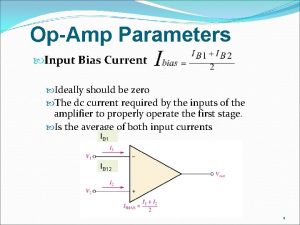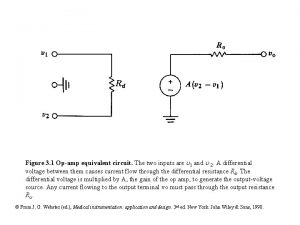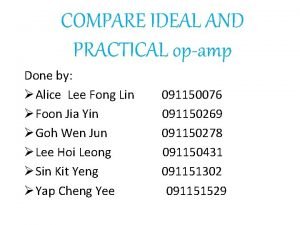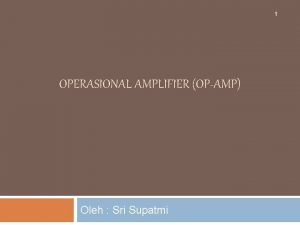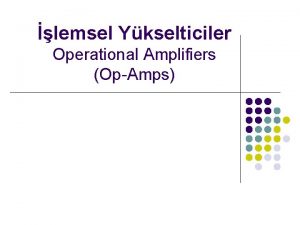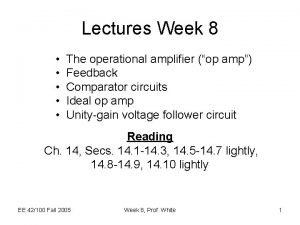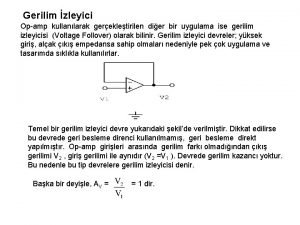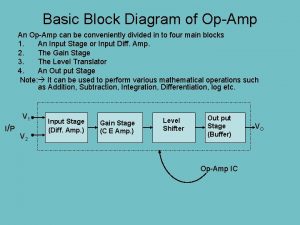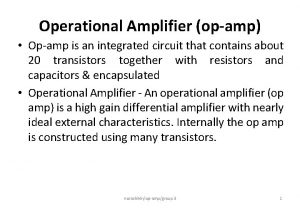AC Characteristics Frequency Response Ideally an opamp should










- Slides: 10

AC Characteristics Frequency Response Ideally, an op-amp should have an infinite bandwidth but practically op-amp gain decreases at higher frequencies. Such a gain reduction with respect to frequency is called as roll off. The plot showing the variations in magnitude and phase angle of the gain due to the change in frequency is called frequency response of the op-amp

When the gain in decibels, phase angle in degrees are plotted against logarithmic scale of frequency, the plot is called Bode Plot The manner in which the gain of the op-amp changes with variation in frequency is known as the magnitude plot. The manner in which the phase shift changes with variation in frequency is known as the phase-angle plot.

Obtaining the frequency response To obtain the frequency response , consider the high frequency model of the op-amp with capacitor C at the output, taking into account the capacitive effect present Where AOL(f) = open loop voltage gain as a function of frequency AOL = Gain of the op-amp at 0 Hz F = operating frequency Fo = Break frequency or cutoff frequency of op-amp

For a given op-amp and selected value of C, the frequency fo is constant. The above equation can be written in the polar form as

Frequency Response of an op-amp

The following observations can be made from the frequency response of an op-amp i) The open loop gain AOL is almost constant from 0 Hz to the break frequency fo. ii) At f=fo , the gain is 3 d. B down from its value at 0 Hz. Hence the frequency fo is also called as -3 d. B frequency. It is also know as corner frequency iii) After f=fo , the gain AOL (f) decreases at a rate of 20 d. B/decade or 6 d. B/octave. As the gain decreases, slope of the magnitude plot is -20 d. B/decade or -6 d. B/octave, after f=fo. iv) At a certain frequency, the gain reduces to 0 d. B. This means 20 log|AOL | is 0 d. B i. e. |AOL | =1. Such a frequency is called gain cross-over frequency or unity gain bandwidth (UGB). It is also called closed loop bandwidth. UGB is the gain bandwidth product only if an op-amp has a single breakover frequency, before AOL (f) d. B is zero.

For an op-amp with single break frequency fo , after fo the gain bandwidth product is constant equal to UGB=AOL fo UGB is also called gain bandwidth product and denoted as ft Thus ft is the product of gain of op-amp and bandwidth. The break frequency is nothing but a corner frequency fo. At this frequency, slope of the magnitude plot changes. The op-amp for which there is only once change in the slope of the magnitude plot, is called single break frequency op-amp.

For a single break frequency we can also write UGB= Af ff Af = closed loop voltage gain Ff = bandwidth with feedback v) The phase angle of an op-amp with single break frequency varies between 00 to 900. The maximum possible phase shift is -900 , i. e. output voltage lags input voltage by 900 when phase shift is maximum vi) At a corner frequency f=fo , the phase shift is -450. F o = UGB / AOL


The modes of using an op-amp • Open Loop : (The output assumes one of the two possible output states, that is +Vsat or – Vsat and the amplifier acts as a switch only). • Closed Loop: ( The utility of an op-amp can be greatly increased by providing negative feed back. The output in this case is not driven into saturation and the circuit behaves in a linear manner).
